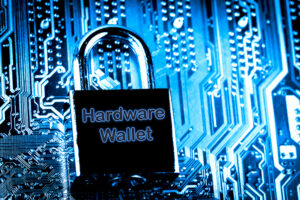You’ve probably heard that you should have a wallet to put your cryptocurrency in. What you may not know is that there is a variety of them available. Which crypto wallet type is right for you depends on what you are doing and the level of security you want.
Here you will learn about the different types of crypto wallets, the different purposes they serve, and which crypto wallet type is best for your needs.
What Is A Crypto Wallet
A crypto wallet is, as it sounds, a place to store your cryptocurrency. They are software in the form of a program or app with a special address you can use to send and receive digital currency and virtual goods (NFTs). There are also hardware wallets, stand-alone devices made to hold cryptocurrency.
Why Wallets Are Important?

Wallets allow you to fully own the cryptocurrency you purchase. When you buy crypto from a centralized exchange like Binance or Coinbase, that exchange holds your crypto in your name.
This means that if they are hacked, or a disgruntled employee takes the money or the money is otherwise mishandled, it is lost.
Crypto exchanges are not beholden to the same Federal regulation that banks are. They don’t have to guarantee your money will be there.
Having a cryptocurrency wallet allows you to fully transfer crypto into your possession.
How do Wallets Work
Wallets exist on the blockchain of the crypto they are based from. Most wallets presently are on the Ethereum chain, however, they can be based on any.
When you create a wallet, you are given a series of words to save. These words are your keys or seed phrase to access the wallet. With these keys, you can access the same account from any wallet that supports that chain.
An example of this is best expressed with traditional banks. This is like saying if you created an account at Wells Fargo, you could go to Chase Bank, Bank of America, or Citi Bank, and access that same account upon login.
This is possible because the account itself doesn’t exist on the phone or computer used to set the wallet up. The account and all of its data and funds exist on the blockchain. The wallet you choose to use is simply an interface to that account.
Are There Risks To Using Crypto Wallets?
Yes. As with all things, there are always risks. Here are a few that you should be aware of:
- You are the custodian
- No reversals
- Fee Responsibility
You Are the Custodian

This means that you are fully responsible for the account and money stored there. Should anything happen, you are the one that will need to fix it.
For example, should you ever lose your seed phrase, you will permanently lose access to all your funds.
No Reversals
You will not be able to reverse transactions.
When a bank manages an account, if the money is sent to an incorrect account, the bank can reverse the transaction. If a wire transfer doesn’t go through, the money will reappear in your account. This is not the case with crypto. Once the money leaves your account, it is gone, regardless of if it arrived at the other end.
Fees
You will need to cover the costs of all fees. You already do this and may not realize it. For example, product purchases often have credit and debit fees worked into their price, even if you are paying cash.
However, fees become very apparent in crypto as they are used to process every action taken. Even if you are simply transferring funds from one account to another.
Benefits of a Wallet
With the risks out of the way, let’s look at why you want to use them. In the crypto space, you will hear the following phrase a lot, “Not your keys, not your crypto.” This is referring to the wallet seed phrase which can also be saved as an encrypted file known as a private key.
When you create an account on a centralized exchange like Binance, they control the wallet. They can place a hold on it (they often do for ACH transfers while it clears), or worse, should they go under, so will your money. When you move your money to your own wallet, no one else can arbitrarily take it, or garnish it, or place a hold on it.
Some wallets like Trust and Metamask support far more currencies than is available on a centralized exchange, allowing you to hold a diverse portfolio of crypto.
Software Wallets

Software crypto wallet types encompass two spheres, browser extensions, and apps.
When it comes to software wallets, there is one that reigns supreme and that is Metamask.
The reason why is because, it supports both these spheres, it is an app that you can install on your phone, and it has a browser extension you can install.
Metamask is used and accepted on almost all crypto related sites, and dapps and can be configured to work with a large variety of currencies making this a very easy one to recommend.
There are, however, other notable wallets worth checking out:
Hardware Wallets
Where software wallets provide ease of use, hardware wallets provide extra security.
Software wallets are still prone to phishing attacks, targeted attempts by bad actors to trick you into giving them your password.
Mobile wallets can be compromised if your phone number is spoofed, a type of attack in which a bad actor is able to use your phone number to use as their own.

Hardware wallets address both of these by being their own physical devices that you can use to store your crypto.
These crypto wallet types are more limiting in the sense that they don’t usually support the same wide range of currencies as their software counterparts, but are more secure in that the only way to take the money from them is to have the device and whatever password you may have set for it.
Even the limitation of supported currencies is becoming a thing of the past as many are now paired with their own software wallet, combining the security of a physical device with the quick upgradability of software.
Such wallets work by adding an additional verification step performed on the hardware device (via QR code) before any money leaves your account.
Some great hardware wallets are:
Which should you use
Now we get to the big question, which crypto wallet type should you use?! If you are looking for simplicity and ease of use, a software wallet will be the way to go.
Metamask in particular works with decentralized web applications, is the most accepted web3 wallet, and has a mobile app you can install to manage your crypto on the go. Making this an easy one to recommend.
However, if you are after ultimate security, then a hardware wallet is what you want. Hardware wallets are ideal for long-term holders or folks who won’t be making transactions often. They are a tad more difficult and tedious to use, but there is nothing safer to protect your crypto.
Depending on which hardware wallet you use you can get the best of both worlds. Wallets like Ledger, Trezor, and Keystone can be linked to a Metamask wallet. This gives you the broad accessibility to dapps, expands your supported assets to just about everything, and still offers the extra protection of requiring validation on the hardware wallet before funds ever leave your account.
Final Thoughts
The world of crypto is confusing enough and crypto wallets add an extra dimension on top of it. It’s easy to see why you may instead choose to keep your money on something familiar and easy to understand like a centralized exchange.
It’s important to remember, however, that exchanges are not banks. They are meant to be a transitory place to put money and conduct transactions.
You want to keep your crypto in a place where you have full control over it. Only then can you properly protect what’s yours.
If you plan to trade frequently (a few times a month) a software wallet solution may be for you.
Do you plan to buy and hold for a number of months? You may want to consider a hardware wallet solution.
If you are like me, a trader who trades multiple times a month but also wants the security of a hardware wallet, then I would recommend Keystone which combines ease of use via touchscreen and accessibility with Metamask integration.

